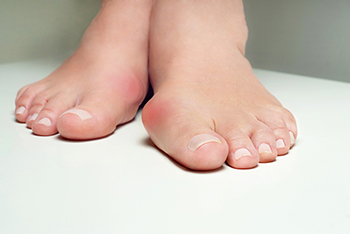
Wilmington (937) 382-2347
Fax
(513) 932-1606

Wilmington (937) 382-2347
Fax
(513) 932-1606

Bunions are all too common and affect all ages of people. They are more apt to happen to women, thought to be because of the pointy-toed, or high-heeled fashionable shoes they wear. However, they are not only caused by shoes, as bunions can happen to people in cultures who do not wear shoes. A bunion is a bony deformity of the big toe joint, also known as hallux valgus. When one has a bunion, their foot appears wider, and shoes can press on the painfully deformed joint. Pressure from the shoes pushes the big toe towards the second toe and the first joint bulges on the side of the foot. As the condition progresses, the second toe may lie over the top of the big toe, which leads to further pressure and distortion of footwear. Hard skin and corns may develop on the bunion and top of the second toe because they rub on shoes. This makes walking difficult, too. Bunions are easy to see. They are red, hot, painful, and swollen. A fluid-filled sac called a bursa sometimes develops over the joint to try and protect it from damage. Due to degenerative changes, arthritis might develop as well. If you suffer from a bunion, make sure to wear shoes that have enough room for the toes to move freely, with the bunion, and see a podiatrist for other suggestions and treatment options.
If you are suffering from bunions, contact Dr. Gerald Perelman of Ohio. Our doctor can provide the care you need to keep you pain-free and on your feet.
What Is a Bunion?
A bunion is formed of swollen tissue or an enlargement of boney growth, usually located at the base joint of the toe that connects to the foot. The swelling occurs due to the bones in the big toe shifting inward, which impacts the other toes of the foot. This causes the area around the base of the big toe to become inflamed and painful.
Why Do Bunions Form?
Genetics – Susceptibility to bunions are often hereditary
Stress on the feet – Poorly fitted and uncomfortable footwear that places stress on feet, such as heels, can worsen existing bunions
How Are Bunions Diagnosed?
Doctors often perform two tests – blood tests and x-rays – when trying to diagnose bunions, especially in the early stages of development. Blood tests help determine if the foot pain is being caused by something else, such as arthritis, while x-rays provide a clear picture of your bone structure to your doctor.
How Are Bunions Treated?
If you have any questions, please feel free to contact our office located in Wilmington, OH . We offer the newest diagnostic and treatment technologies for all your foot care needs.